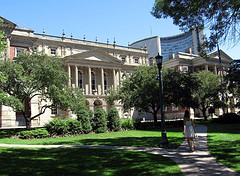 The recent death of Donald Marshall has prompted renewed public and media interest in the topic of wrongful convictions in Canada. Lately, we’ve seen everything from looks back at famous cases in our country’s legal history to reflections on how much more still must be done to protect Canadians against being sent to prison for a crime they didn’t commit.
The recent death of Donald Marshall has prompted renewed public and media interest in the topic of wrongful convictions in Canada. Lately, we’ve seen everything from looks back at famous cases in our country’s legal history to reflections on how much more still must be done to protect Canadians against being sent to prison for a crime they didn’t commit.
Central to any such discussion is the Association in Defence of the Wrongly Convicted (AIDWYC). The group has been at the forefront of many of Canada’s high-profile exonerations, and it continues to work on behalf of people seeking to clear their names.
It’s only a matter of time before someone else follows the footsteps of Marshall, David Milgaard and Guy-Paul Morin to freedom and vindication. Here’s a look at some of the candidates whose cases are currently being fought by the AIDWYC.
Tammy Marquardt
On October 25, 1995, Marquardt was found guilty of second degree murder in the death of her toddler son. She was sentenced to life, although she could have served as little as 20 months had she agreed to the Crown’s offer of five years for manslaughter.
Marquardt appealed her conviction and lost in 1998, and got in touch with the AIDWYC some six years later. In the intervening time, the findings of Dr. Charles Smith — the pathologist whose testimony was crucial to her guilty verdict — were discredited by several experts as part of a public inquiry. Smith testified at the trial that Marquardt’s son had died as a result of being smothered or strangled.
“She didn’t kill her son; it’s pretty simple,” Marquardt’s lawyer and AIDWYC Founding Director James Lockyer told the National Post. Her son had epilepsy. Newfoundland Chief Medical Examiner Dr. Simon Avis and five other forensic experts believe that the boy could have died of a seizure, or of natural causes.
Released on bail this past March, Marquardt had her case reopened by the Supreme Court in May. It’s currenty set to be heard by the Ontario Court of Appeal.
Kyle Unger
A partial hair found near the body of Brigitte Grenier led to finding Kyle Unger and Timothy Houlahan guilty of murdering the 16-year-old girl in 1990 at a music festival near Winnipeg. Both were convicted in 1992. Unger served 13 years before the AIDWYC submitted an application to review the case, which resulted in his release on bail in 2005. The previous September, the Manitoba Hair Evidence Review Committee called the hair evidence into question, and DNA testing revealed that it did not belong to Unger. (Houlahan was released on bail in 1994, but committed suicide later that same year.)
Unger was granted a new trial this past March. Just this past Wednesday, his case was put over for another month.
Romeo Phillion
Convicted of murder in 1972, Phillion served 31 years before being released on bail following efforts by the AIDWYC and the Osgoode Hall Innocence Project (which shares its name with American organization founded in 1992 by O.J. Simpson legal team member Barry Scheck) to bring to light new evidence concerning Phillion’s whereabouts at the time of the murder. He maintains that he was 200 kilometres away when firefighter Leopold Roy was killed in Ottawa on August 9, 1967.
The appeal process of Phillion’s conviction also brought forward new thinking on the subject of false confessions (Phillion confessed to the crime, only to recount hours later), and prompted the Supreme Court to reject the use of polygraph results in trials.
Phillion had reason to celebrate earlier this year when, after hearings at home and in London, England, the Ontario Court of Appeal overturned his conviction and freed him from his bail conditions — which included restrictions on travel outside of Ontario, regular reporting to police, and living with a surety. The court ordered a new trial, but Ontario Attorney General Chris Bentley stated that he would not proceed because too much time has passed and many of the witnesses have since died.
All that’s currently standing between Phillion and total exoneration is a decision by Bentley. The AG’s three options are: stay the proceedings; withdraw the charges; or bring Phillion back into court for arraignment and to enter a plea. He would then be acquitted, since the Crown would advise that it has no witnesses to call. The AIDWYC favours the third option.

